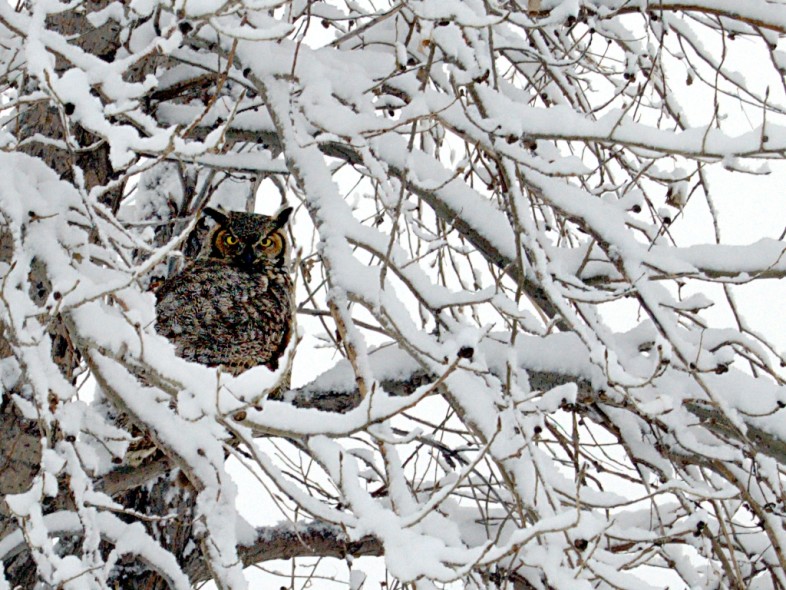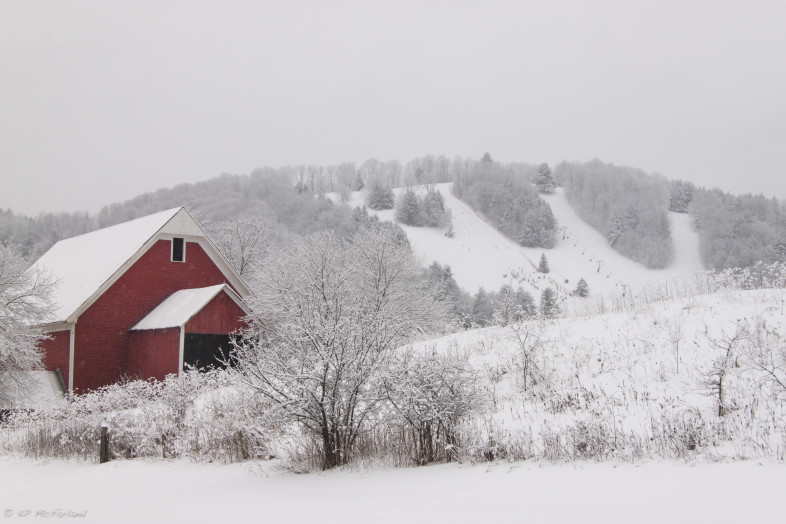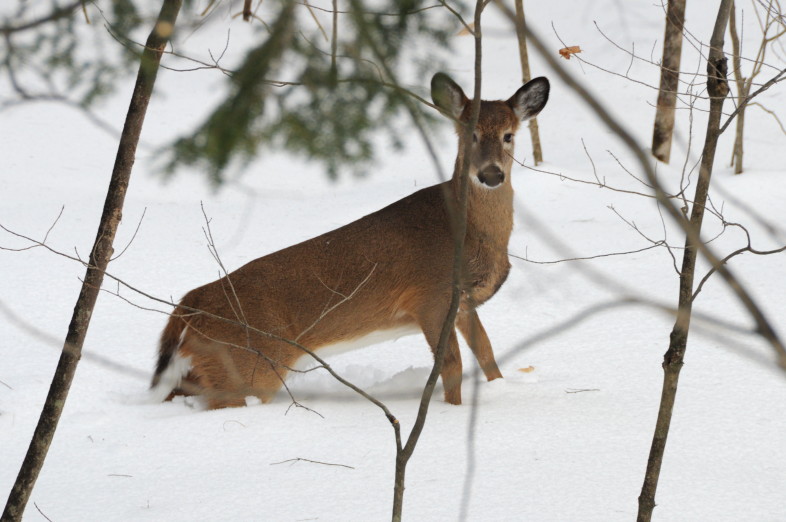With record-breaking temperatures and lack of snowfall in December, many of us are hoping that the traditional “January thaw” will bypass us this year, if it even exists at all (more on that below). With or without the weather anomalies, there’s plenty of life outdoors for us to discover in deep winter. Here are a few tidbits to get you to bundle up and head out the door.
“Who” Lays The First Eggs of 2016?
Listen for Great Horned Owls advertising their territories with deep, soft hoots in a stuttering rhythm: hoo-h’HOO-hoo-hoo. It can carry a mile or more. Both sexes hoot, with the female call higher pitched and consisting of 7 or 8 syllables. Even though the female Great Horned Owl is bigger, the male has a larger voice box and a deeper voice. Pairs often call together, with audible differences in pitch.
Great Horned Owls are one of the earliest species to nest in the Northeast, and are often brooding eggs as early as January. For nesting sites they use old hawk, eagle, heron or osprey nests, squirrel nests, tree hollows, or cliffs. Check out the Vermont eBird map to see all the sightings reported in January. From the first to the second Vermont Breeding Bird Atlas, Great Horned Owls decreased by 33% (57 to 38 blocks) with the greatest decrease in Taconic Mountains.
If you hear an agitated group of cawing American Crows, they may be mobbing a Great Horned Owl. Crows may gather from near and far and harass the owl for hours. The crows have good reason, because the Great Horned Owl is their most dangerous predator.
Great Horned Owls are covered in extremely soft feathers that insulate them against the cold winter weather and help them fly very quietly in pursuit of prey. Their short, wide wings allow them to maneuver in the forest while hunting prey.
Myth Buster: The January Thaw
January 23 is the coldest day of the year on average in much of the Northern Hemisphere. During the final week of January, temperatures are thought to show a slight increase, and subsequent dip. The January thaw, as it has been named, is said to last for about a week. Researchers from Cornell University and the National Oceanic and Atmospheric Administration aimed to find out if this piece of meteorological folklore was fact or fiction. Their analysis published in the Bulletin of the American Meteorological Society in 2002 concluded that “the effects of sampling in finite climate records are wholly adequate to account for the existence of January thaw “features” in northeastern U.S. temperature data.” They also state, “While this powerful human capacity to find order in nature has served and continues to serve us extremely well, it also sometimes leads us to falsely impute meaning to chance events.” In other words, it’s all in our heads. There is no January thaw in the records according to their analysis.
Conservation Zone: Deer Yards
White-tailed Deer survive the harsh northern winters using specific winter habitat, what most of us call “deeryards.” These areas have ample evergreen cover on slopes that often have a southerly aspect, providing protection from deep snow, cold temperatures, and wind. Deer yards might be only a few acres to perhaps as large as 100 acres. If they remain intact, these yards can be used for generations. Deer may migrate from miles around in late fall to use these areas for the winter. The deer cut their metabolism in half during this time of scarcity in an effort to make it until the lush grasses of spring arrive.
Deer yards are also important for a variety of other wildlife: porcupines, snowshoe hare, fox, fisher, coyotes, bobcats, American crows, Common ravens, crossbills, owls and more. Human encroachment or forestry operations can have a devastating effect on these stands and the wildlife that rely on them. Deer yards make up a small percentage of the land cover in Vermont. Only 6-8% of the forested landscape of Vermont has been identified as deeryard.
While low temperatures can have an impact on deer with low fat reserves, landowners can help deer maintain those reserves through winter by providing suitable winter habitat. They are typically found in mature and mixed-age spruce-fir or hemlock stands, but other evergreen species such as cedar and pine may capture enough snow in their canopy to reduce snow to a depth suitable for daily movements of deer. Deer wintering areas are often found on south-facing slopes. Short-wave radiation from the sun has little influence on highly reflective snow. However, snow is highly absorbent of long-wave radiation that is converted from the sun and emitted by trees. Dense softwood stands reduce wind, capture heat from long-wave radiation, and promote sublimation (solid to vapor) of snow from the base and canopy of trees. The result is less snow on the ground and a favorable microclimate that reduces energy expenditure by deer that are struggling to survive.
A Bark in the Night
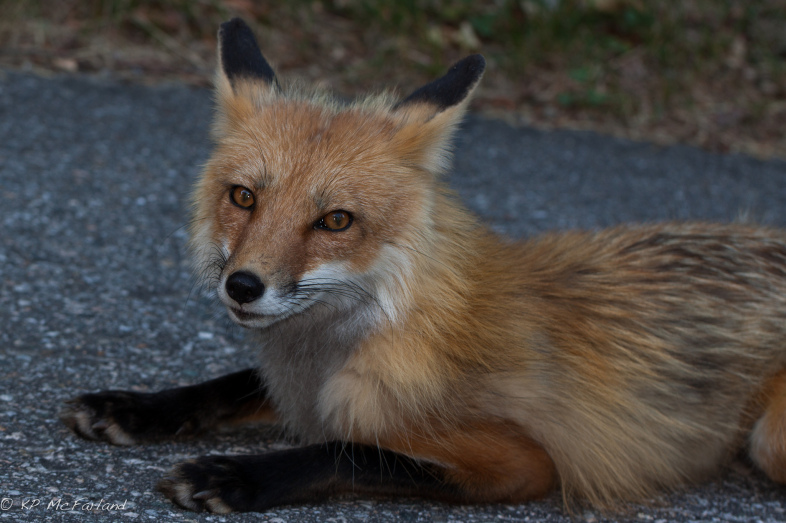
Red Fox / © K.P. McFarland
Adult Red Foxes are usually solitary until mating season, which begins this month and lasts until early March in New England. Red Fox attract each other with series of barking at night. High-pitched screams or barks at night, often thought to be Fisher, are usually calls from fox. Fisher are quiet animals.
Listen to the distant barking screams of a Red Fox recorded in Woodstock, Vermont.
During the cold New England winters, red foxes stay warm by growing a long winter coat. An adult fox rarely retreats to a den during the winter, but will instead curl into a ball in the open, using its bushy tail to wrap around its nose and footpads. Many times, they can be found completely blanketed in snow. With the onset of spring, red foxes shed their winter fur and prepare for warmer weather.
Troubled Beech
With all the leaves down, it’s hard to walk through the forest without noticing the pocked trunks of American Beech (Fagus grandifolia) trees. A mature tree with smooth gray bark is a rare sight now. The culprit is beech bark disease.
It’s caused by a unique relationship between an introduced insect called the Beech Bark Scale (Cryptococcus fagisuga), and Nectria fungi (Nectria coccinea var. faginata and N. galligena). This disease has been known in Europe since at least the 1840s, where it attacks European Beech (F. sylvatica).
It was accidentally introduced to North American at Halifax, Nova Scotia, in 1890, on a shipment of ornamental trees.
The infestation spreads about 10 miles per year, mainly from the dispersal of Beech Bark Scale by wind and animals. It first appeared in New England in 1929 when it was found in Maine. By 1950 it was found throughout the entire state, and by 1960 it was found across New England. Today it is as far west as Wisconsin and south into North Carolina and Tennessee.
Since there are few natural controls known, the disease is likely to become established across the entire range of American Beech. The native Twice-stabbed Ladybird Beetle (Chilocorus stigma), aptly named for the two bright red spots on each side of its black back, preys on Beech Bark Scale, but isn’t able to drastically limit the population.

Beech Bark Scale is easy to see on infected trees in the fall. They exude small but noticeable white, waxy filaments on tree trunks. These wingless insects are parthenogenetic, egg growth and development occurs without fertilization by a male and all offspring are females. Adults lay eggs in the summer which soon hatch and the young nymphs, called crawlers, move into bark fissures or may be carried to other trees by wind or wildlife. Once the young crawlers settle down they push their stylet, a sharp needle-like mouthpart, into the bark and begin feeding and secreting the woolly wax cover that they use to help survive the winter season.
The minute wounds created by the stylets allow Nectria fungi to colonize. The fungal colonies cause cankers on the bark surface. This quickly leads to wilting of leaves and loss of twigs and branches. Eventually, the cankers cause enough damage around the tree that the trunk simply snaps in a wind storm. Beech snap is now common throughout the New England forest.
 This is bad news for the wildlife that depends on beech for survival. Bear, deer and turkey rely on the energy rich beech nuts in the fall. The Early Hairstreak (Erora laeta), a tiny blue butterfly whose caterpillars feed on beech flowers, is found in beech forests. There is at least a glimmer of hope. Some resistant trees have been found and are now being produced in nurseries with the hope that they could be transplanted throughout the range to perhaps bring healthy beech slowly back to the forest.
This is bad news for the wildlife that depends on beech for survival. Bear, deer and turkey rely on the energy rich beech nuts in the fall. The Early Hairstreak (Erora laeta), a tiny blue butterfly whose caterpillars feed on beech flowers, is found in beech forests. There is at least a glimmer of hope. Some resistant trees have been found and are now being produced in nurseries with the hope that they could be transplanted throughout the range to perhaps bring healthy beech slowly back to the forest.
Snowbird Social Life at Your Bird Feeder
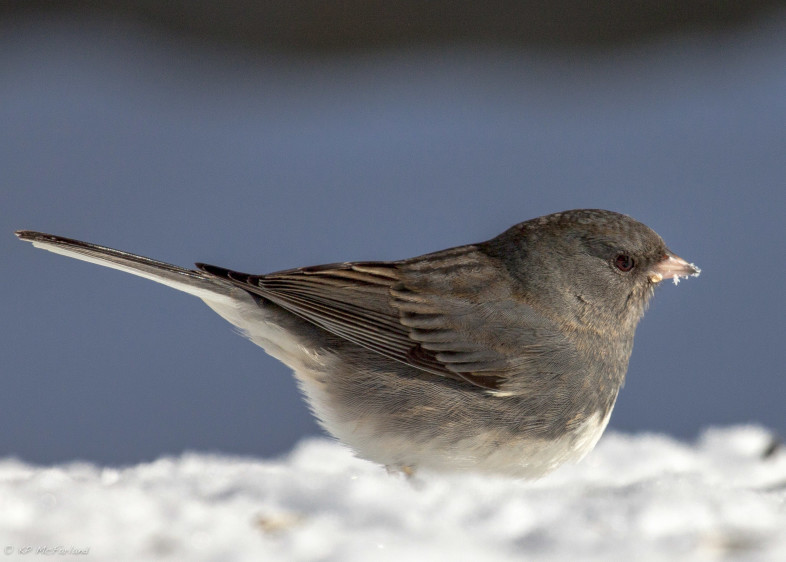
Dark-eyed Junco. / © K.P. McFarland
Dark-eyed Juncos, also known as ‘snowbirds’, spend the winter in small flocks. Each flock has a dominance hierarchy with adult males at the top, followed by juvenile males, and females at the bottom. Watch them at your feeders and you can often observe individuals challenging the status of others with aggressive displays of lunges and tail flicking. But the farther north you are, the fewer females you will see in the flock.
To avoid competition, many females migrate farther south than most of the males. Up to 70% of Juncos wintering in the southern U.S. are females. Males tend to stay farther north in order to shorten their spring migration and perhaps gain the advantage of arriving first at prime breeding territories.

